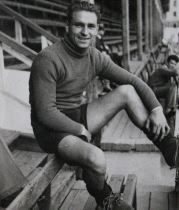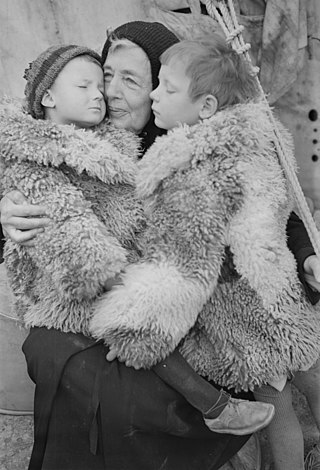
The Gulag was a system of forced labor camps in the Soviet Union. The word Gulag originally referred only to the division of the Soviet secret police that was in charge of running the forced labor camps from the 1930s to the early 1950s during Joseph Stalin's rule, but in English literature the term is popularly used for the system of forced labor throughout the Soviet era. The abbreviation GULAG (ГУЛАГ) stands for "Гла́вное Управле́ние исправи́тельно-трудовы́х ЛАГере́й", but the full official name of the agency changed several times.
Operation Keelhaul was a forced repatriation of Soviet citizens and members of the Soviet Army in the West to the Soviet Union after World War II. While forced repatriation focused on Soviet Armed Forces POWs of Germany and Russian Liberation Army members, it included many other people under Allied control. Refoulement, the forced repatriation of people in danger of persecution, is a human rights violation and breach of international law. Thus Operation Keelhaul would have been called a war crime under modern international humanitarian law, especially in regards to the many civilians forced into Soviet work camps, many of whom had never been Soviet citizens, having fled Russia before the end of the Russian Civil War.
Mass evacuation, forced displacement, expulsion, and deportation of millions of people took place across most countries involved in World War II. The Second World War caused the movement of the largest number of people in the shortest period of time in history. A number of these phenomena were categorised as violations of fundamental human values and norms by the Nuremberg Tribunal after the war ended. The mass movement of people – most of them refugees – had either been caused by the hostilities, or enforced by the former Axis and the Allied powers based on ideologies of race and ethnicity, culminating in the postwar border changes enacted by international settlements. The refugee crisis created across formerly occupied territories in World War II provided the context for much of the new international refugee and global human rights architecture existing today.

Sabino Policarpo Arana Goiri, Sabin Polikarpo Arana Goiri, or Arana ta Goiri'taŕ Sabin (self-styled), was a Spanish writer and the founder of the Basque Nationalist Party (PNV). Arana is considered the father of Basque nationalism.

Displaced persons camps in post–World War II Europe were established in Germany, Austria, and Italy, primarily for refugees from Eastern Europe and for the former inmates of the Nazi German concentration camps. A "displaced persons camp" is a temporary facility for displaced persons, whether refugees or internally displaced persons. Two years after the end of World War II in Europe, some 850,000 people lived in displaced persons camps across Europe, among them Armenians, Czechoslovaks, Estonians, Greeks, Poles, Latvians, Lithuanians, Yugoslavs, Jews, Russians, Ukrainians, Hungarians, Kalmyks, and Belarusians.
Sh'erit ha-Pletah is a Hebrew term for Jewish Holocaust survivors living in Displaced Persons (DP) camps, and the organisations they created to act on their behalf with the Allied authorities. These were active between 27 May 1945 and 1950–51, when the last DP camps closed.
The repatriation of the Cossacks or betrayal of the Cossacks occurred when Cossacks, ethnic Russians and Ukrainians who were opposed to the Soviet Union and fought for Nazi Germany, were handed over by British and American forces to the Soviet Union after the conclusion of World War II. Towards the end of the European theatre of World War II, many Cossacks forces with civilians in tow retreated to Western Europe. Their goal was to avoid capture and imprisonment by the Red Army for treason, and hoped for a better outcome by surrendering to the Western Allies, such as to the British and Americans. However, after being taken prisoner by the Allies, they were packed into small trains. Unbeknownst to them, they were sent east to Soviet territories. Many men, women and children were subsequently sent to the Gulag prison camps, where some were brutally worked to death. The repatriations were agreed upon at the Yalta Conference; Soviet leader Joseph Stalin claimed that the prisoners were Soviet citizens as of 1939, although there were many of them that had left the country before or soon after the end of the Russian Civil War or had been born abroad, hence never holding Soviet citizenship.
In the decades since the Holocaust, some national governments, international bodies and world leaders have been criticized for their failure to take appropriate action to save the millions of European Jews, Roma, and other victims of the Holocaust. Critics say that such intervention, particularly by the Allied governments, might have saved substantial numbers of people and could have been accomplished without the diversion of significant resources from the war effort.

Raimundo Pérez Lezama was a Spanish footballer who played as a goalkeeper.
Emilio Aldecoa Gómez was a Spanish professional footballer who played in the English and Spanish football leagues and later managed in Spain and England. He made one appearance for the Spain national team, as a substitute in a 2–1 win against Ireland in May 1948 at the Montjuic Stadium, Barcelona.

Spaniards in the United Kingdom are people of Spanish descent resident in Britain. They may be British citizens or non-citizen immigrants.

Victims of Yalta or The Secret Betrayal is a 1977 book by Nikolai Tolstoy that chronicles the fate of Soviet citizens who had been under German control during World War II and at its end fallen into the hands of the Western Allies. According to the secret Moscow agreement from 1944 that was confirmed at the 1945 Yalta conference, all citizens of the Soviet Union were to be repatriated without choice—a death sentence for many by execution or extermination through labour.
Sabino Barinaga Alberdi was a Spanish football forward and manager.
Hampshire has always been a popular destination for immigrants, with the ports at Portsmouth and Southampton receiving immigrants from all over Europe and being the starting point for voyages to the New World. Southampton Docks rapidly expanded since their creation in 1850, and saw increasing traffic with South Africa, Australia and the Americas.
José Augustin "Joe" Gallego, was a Spanish footballer who played as an outside forward for various clubs in the English Football League in the 1940s and 1950s.

The Republican faction, also known as the Loyalist faction or the Government faction, was the side in the Spanish Civil War of 1936 to 1939 that supported the government of the Second Spanish Republic against the Nationalist faction of the military rebellion. The name Republicans was mainly used by its members and supporters, while its opponents used the term Rojos (Reds) to refer to this faction due to its left-leaning ideology, including far-left communist and anarchist groups, and the support it received from the Soviet Union. At the beginning of the war, the Republicans outnumbered the Nationalists by ten-to-one, but by January 1937 that advantage had dropped to four-to-one.

Following the Soviet invasion of Poland at the onset of World War II, in accordance with the Nazi-Soviet Pact against Poland, the Soviet Union acquired more than half of the territory of the Second Polish Republic or about 201,000 square kilometres (78,000 sq mi) inhabited by more than 13,200,000 people. Within months, in order to de-Polonize annexed lands, the Soviet NKVD rounded up and deported between 320,000 and 1 million Polish nationals to the eastern parts of the USSR, the Urals, and Siberia. There were four waves of deportations of entire families with children, women, and elderly people aboard freight trains from 1940 until 1941. The second wave of deportations by the Soviet occupational forces across the Kresy macroregion, affected 300,000 to 330,000 Poles, sent primarily to Kazakhstan.

The Niños de Rusia were the 2,895 children evacuated to the Soviet Union by the authorities of the Second Spanish Republic during the Spanish Civil War. During 1937 and 1938, the children were sent from the Republican zone to the Soviet Union to avoid the rigours of war. Spanish children were sent to several other countries as well as Russia during this period and they are more widely referred to as Niños de la Guerra.
Araceli Sánchez Urquijo was a Niños de Rusia child evacuee during the Spanish Civil War and the first woman to work as a civil engineer in Spain.

On 13 June 1943, Real Madrid defeated Barcelona 11–1 in the second leg of the Copa del Generalísimo semi-finals, the Spanish Cup having been renamed in honor of General Francisco Franco.










